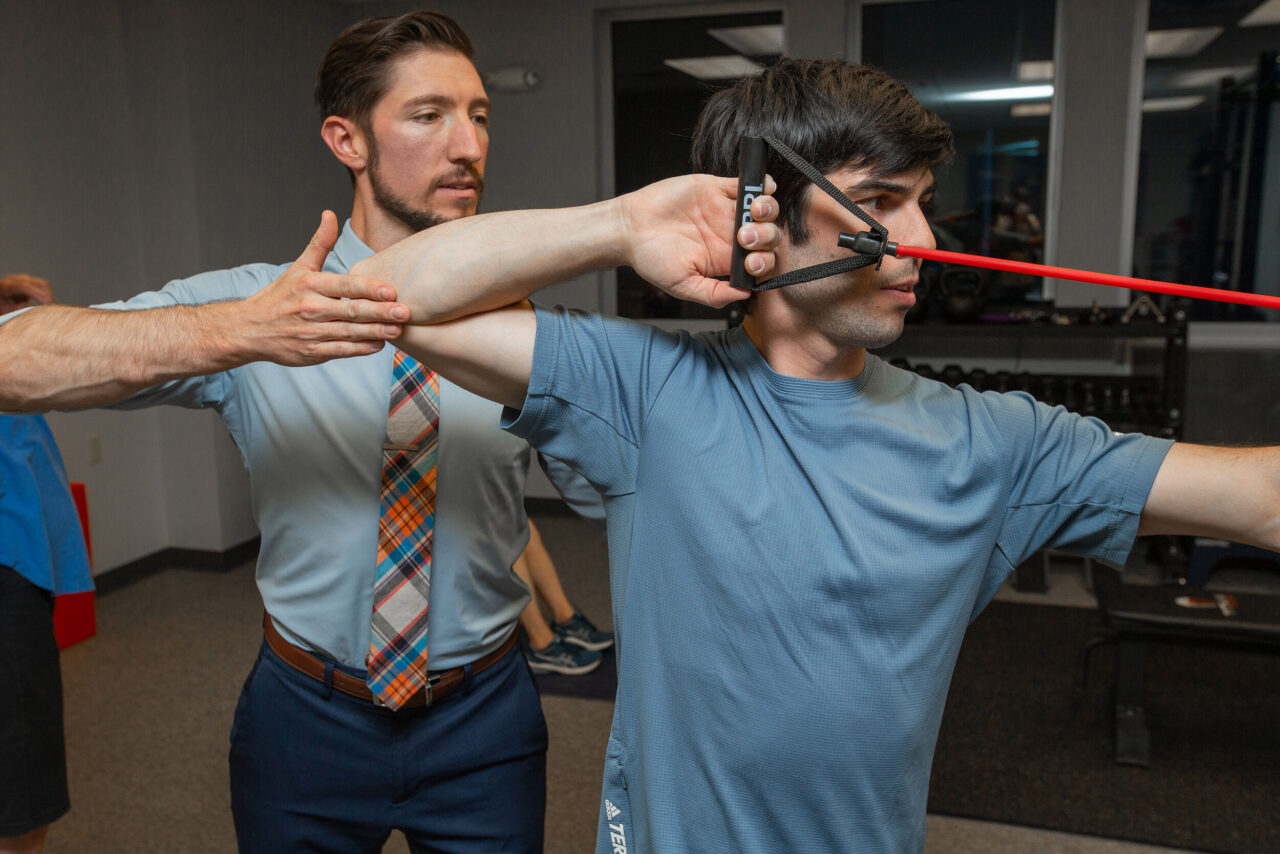
The shoulder is an integral component of a climber’s ability to scale walls efficiently and effectively. It allows for an incredible range of motion that makes spanning large distances and cramming yourself into cracks possible. However, the same mobility that makes it so valuable also makes it susceptible to injury. Shoulder issues account for 17% of climbing related injuries, often leading to frustrating setbacks and time away from the wall.
This guide is designed to be a comprehensive resource for climbers. We will explore the common causes of shoulder pain, discuss modern, evidence-based treatment approaches, and provide actionable advice for long-term shoulder health and performance. This information is based on our clinical experience as Doctors of Physical Therapy specializing in treating climbers in the Boulder and Lafayette communities.
Ready for an expert diagnosis? Schedule a Consultation with a Climbing Specialist.
Understanding Common Climbing Shoulder Injuries
The shoulder is a highly mobile joint that requires complex muscular coordination to effectively move the arm. The shoulder has few passive constraints that allow it to move in an incredible range of motion; its function is highly dependent on the surrounding musculature to maintain its alignment and stability while performing athletic movements. Shoulder injuries in climbing occur from acute typically large force or extreme angle events or from chronic overuse injuries. Despite the differences in mechanism, the result can lead to similar injury areas. However, the mechanism of injury can greatly alter the treatment plan of the affected area. Acute injuries occur when the forces placed on the shoulder exceed the capacity of the bones, muscles, tendons, and ligaments of the shoulder. While over-use injuries occur when the load-volume to rest rest ratio exceeds the capacity of the shoulder tissues. This is influenced by the amount of climbing/training completed in a given time, the type of training completed, and the amount of rest given to adequately recover from a gym session or a day out at the crag.
Subacromial Pain Syndrome (Shoulder Impingement)
This is often felt as a “pinching” sensation in the front or top of the shoulder. It occurs when the rotator cuff tendons and bursa are compressed in the narrow space beneath the acromion (a part of the shoulder blade). For climbers, this is frequently aggravated by overhead reaching, gaston moves, or any movement where the arm is extended. The pain can intensify as muscle fatigues during a session or aggravating arm positions are repeated.
Rotator Cuff Strain & Tendinopathy
The rotator cuff is a group of four crucial muscles that stabilize the “ball” in the “socket” of the shoulder. They are essential for controlling movement and providing stability during dynamic and static climbing moves. Overuse can lead to inflammation (tendinopathy) or strains (micro-tears) in these tendons, resulting in a deep ache, weakness during pulling, or pain during lock-offs.
Biceps Tendinopathy
Pain located at the front of the shoulder, especially during underclings or intense pulling exercises like pull-ups, often points to biceps tendinopathy. The long head of the biceps tendon runs in a groove at the front of the shoulder and can become irritated and inflamed from the high tensile forces common in climbing. This is a frequent cause of shoulder pain with pull ups and can significantly impact training.
Evidence-Based Treatment for Climbing Shoulder Injuries
A successful recovery plan moves beyond simple rest. Excellent physical therapy first focuses on determining an accurate diagnosis. With an accurate diagnosis, expertly provided manual therapy can be used to improve mobility, increase neuromuscular control, decrease pain, and restore strength. And most importantly, a physical therapist will provide a targeted therapeutic exercise plan, customized to the individual, to resolve identified impairments in the shoulder.
The Importance of an Accurate Diagnosis
The first step is always a thorough evaluation. A Doctor of Physical Therapy will assess not just the site of pain, but your overall movement patterns, mobility, and strength. Understanding the root cause—whether it’s poor scapular control, limited thoracic spine mobility, muscle imbalances, or poor training behaviors —is the key to a lasting solution.
Manual Therapy Techniques to Restore Function
Hands-on treatment can be highly effective for reducing pain and improving function in the early stages of rehab.
- Soft Tissue Mobilization: This technique helps to release tension in overworked muscles and break down scar tissue, improving flexibility.
- Joint Mobilization: Gentle, targeted movements can help restore the natural glide and rotation of the shoulder joint, reducing stiffness and impingement.
- Dry Needling: This skilled technique uses a fine needle to target deep, painful trigger points in muscles. For climbers, this can be especially effective for releasing tension in the lats, upper back, and rotator cuff, providing significant pain relief and improved range of motion.
- Muscular facilitation techniques: Therapists can help to drive greater neurological control and coordination of the shoulder through a number of activities designed to take advantage of the nervous system’s function and the brain’s learning abilities.
Rehabilitative Exercise: The Foundation of Recovery
While manual therapy provides a window of opportunity, targeted exercise is what creates long-term change. A climbing physical therapy program is distinct from generic rehab; it focuses on:
- Scapular Stability: Strengthening the muscles that control the shoulder blade (like the serratus anterior and lower trapezius) to provide a stable base for all arm movements.
- Rotator Cuff Strengthening: Progressively loading the rotator cuff to handle the demands of climbing without strain.
- Movement Pattern Retraining: Correcting faulty mechanics and building strength in patterns that translate directly to the climbing wall.
Goals of Rehabilitation and Preventing Future Injury
The ultimate goal of physical therapy is not just to be pain-free, but to return to climbing as a more knowledgeable and resilient athlete.
Key Milestones in Recovery
- Pain and Inflammation Control: The initial phase focuses on calming the irritated tissues.
- Restoration of Motion: Regaining full, pain-free range of motion in the shoulder and surrounding joints.
- Building Foundational Strength: Developing strength in the core, scapular muscles, and rotator cuff.
- Sport-Specific Loading: Gradually re-introducing climbing movements and loads in a controlled manner to ensure the shoulder is ready for the demands of the sport.
Actionable Strategies for Shoulder Injury Prevention
- Control your load-volume: Capacity is built over a long time. When you are trying to improve your climbing or just trying to get a lot of it in, you run the risk of exceeding your body’s tissue capacity, leading to injury. Avoid training while fatigued. Make sure you are scheduling rest days to allow your body to recover.
- Master the “Active Hang”: When hanging, don’t just hang passively. Actively engage your scapula by pulling your shoulders down and away from your ears. This builds crucial stability.
- Prioritize Antagonist Work: Climbing is a “pull-dominant” sport. Balance this by regularly training opposing “push” muscles (e.g., push-ups, overhead press) and external rotation to maintain shoulder health.
- Perform a Shoulder Self-Screen: Before it becomes a problem, check your shoulder health. Can you raise both arms overhead symmetrically? Can you reach your thumb up your back equally on both sides? Noticing a difference can be an early warning sign of an imbalance that needs attention.
Frequently Asked Questions on Climbing Injuries
How long does shoulder rehab take?
This varies based on the individual and the injury, but general timelines for dedicated climbers are:
- Subacromial Pain Syndrome: 6 to 12 weeks.
- Rotator Cuff Pain: 8 to 16 weeks.
- Biceps Tendinopathy: 6 to 16 weeks.
An early and accurate diagnosis is the most important factor for a speedy recovery.
Can I still climb with shoulder pain?
In many cases, yes, with modifications. A physical therapist can help you identify which movements to avoid and create a plan that allows you to continue climbing at a modified intensity while your injury heals, which is often more effective than complete rest.
A therapist who understands climbing can diagnose your injury within the context of the sport’s unique demands. They can provide rehab exercises that directly translate to better movement on the wall and offer advice on technique modification, training load management, and how to safely return to your projects.
Do I need a doctor’s referral to see a physical therapist in Colorado?
No. Colorado has Direct Access laws, meaning you can schedule an appointment directly with a physical therapist to get your injury evaluated and treated without delay.
Getting Expert Shoulder Physical Therapy in Boulder & Lafayette
Navigating a shoulder injury can be complex, but you don’t have to do it alone. Working with a physical therapist who specializes in treating climbers is the most effective way to ensure a safe and successful return to the sport you love.
If you are experiencing persistent shoulder pain or want to address an underlying issue to prevent future injury, we invite you to schedule a consultation.
Mend Boulder
Mend Lafayette
